| |
|
The River Stour forms most
of the border between Suffolk and Essex, and on
either side are some of England's loveliest
villages. On a hot summer's day, Cavendish with
its wide green, its medieval cottages and ancient
inns, its pretty church in its tight tree-lined
churchyard, is a fine place to be. This is the
antithesis of the copses and fields which form
the setting for so many of Suffolk's churches,
for this is England tamed and civilised, and the
sheer Englishness of the setting, especially when
seen from behind a pint outside the pub, can
inspire mild feelings of patriotism in even the
dourest globalist. No wonder Americans love
Cavendish so much. One American who loved
Cavendish was John Appleby, whose book A
Suffolk Summer has become more elegiac as
the years go by. He was an American serviceman
stationed near Cavendish, and in the year the
Second World War ended he made a series of
journeys around Suffolk while he waited to be
demobbed, and it is worth reading if only to see
how busy these quiet Stour Valley villages were
in those days.
There
was great wealth here in the late Middle Ages,
and this built the substantial exterior of St
Mary. The church we see today began to come
together in the early 14th Century, when the
great tower was erected against an earlier
church. In 1381 Sir John Cavendish left the
enormous sum of £40 to the building of a new
chancel, which presumably was enough to pay for
it in entirety. As it turns out this was one of
the less likely, and perhaps more fortunate,
outcomes of the Peasants' Revolt, for Sir John
had been lynched on the grounds that it was his
son who had Wat Tyler put to death, the
parishioners of Cavendish reaping the benefits of
his demise.
This
was only the first of a number of bequests
recorded by Peter Northeast and Simon Cotton,
which in their way tell the story of the church's
construction. In 1471 Richard Cagge left money to
the fabric of the new aisle to be made on the
south side of the church, while in 1483 John
Smyth left £20 to the making of the coorce
of the said church of Cavendish, thus the
nave was being rebuilt at this time. Thereafter
there are a number of bequests for furnishings,
suggesting that the church was structurally
complete by then, with the icing on the cake
being Thomas Goldyinge's bequest in English of
1504 which states that I bequeth of my goodes
and catalles asmoch mony as conveinently will
serve to the beiyng of a newe tenoure belleto be
according in true musike unto the iiii belles
nowe hangyng in the steple of Cavendiish
aforesaid.
You
step into a church which is bright, neat and full
of light. It is larger than you might expect when
approaching the south porch through the tight
churchyard. There is very little coloured glass,
and the crispness of an early 21st Century
makeover allows a real appreciation of the
structure. It is a fine setting for several
interesting details. The 15th Century font came
as part of the new nave, but the most striking
feature which faces you across the church from
the north aisle was not originally from this
church at all. This is a large canopied reredos
by Ninian Comper, made in 1895 for the private
chapel in London of Athelstan Riley and brought
here after his death. The central part of the
reredos is a 16th Century Flemish panel,
presumably once part of an altarpiece, depicting
an animated Crucifixion with plenty of figures
milling around beneath including Roman soldiers
casting lots for Christ's garments. The gilded
figures beneath are Comper's.
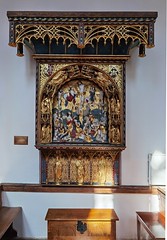  
 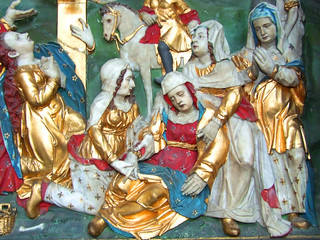 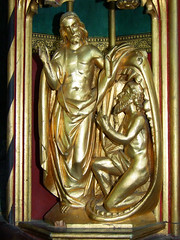
The reredos is
one of several reminders of an Anglo-Catholic
enthusiasm here in the early part of the 20th
Century, and the late Sam Mortlock bemoaned that
the reredos was no longer in use in the chancel,
considering that it had been reduced to the
status of an artifact by being placed on
display in the nave, but it must be said that the
clean, clear space of the chancel manages well
without it. Another reminder of that early 20th
Century enthusiasm is across in the south aisle
where a very good window of 1922 depicts the
Blessed Virgin and Christchild flanked by angels.
It remembers Emmeline Fanny Edmonds and asks in
Latin for prayers for her soul. It's the work of
Clement Skilbeck and is, I think, his only work
in Suffolk although there is some over the border
in Cambridgeshire. The Journal of Stained
Glass Glass House Special notes a letter
which survives in the archives from the Glass
House at Fulham quoting for a three-light window
but commenting that the sketch is rather
vague as to how much background painting there
will be. Fortunately, in the event there
would be hardly any, leaving us with this
charming period piece. It is interesting to note
from the inscription in the glass that Miss
Edmonds had died on the 6th February 1922 and the
letter, which is obviously a reply to a
commission, is dated 9th March 1922. This seems a
remarkably short period of time, so perhaps she
had left instructions in her will for the window
having previously arranged its installation with
the parish.
  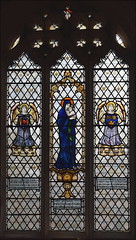

At
the east end of the south aisle is the tomb chest
for Sir George Colt, who died in 1570. At this
time, our English churches were still in a
ferment, and until the late 1530s a chantry altar
had probably stood here, perhaps for a guild. You
can still see the squint that allowed the
celebrant in the chapel a view of the high altar,
necessary because a side chapel Mass could not
begin until the high altar Mass was underway. The
canopied niche to the right of the chest contains
a modern image of the Madonna and child, and may
very well have contained something similar until
the 1530s. Colt's tomb, and its placement in such
a sacred space, must have sent a clear message to
the people of Cavendish that their old religion
was over. Stepping up into the light of the
chancel, you can look up to see Cavendish's best
medieval survival. This is the canopy of honour
over the sanctuary dating from the end of the
14th Century and carefully restored in the 1860s.
Silvered oak faces stare out from panels
decorated with wild flowers.
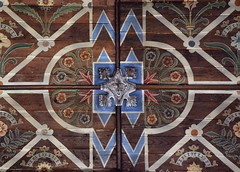  
A
large roundel memorial in the south aisle
remembers the two most famous recent residents of
this parish, Baroness Sue Ryder and Baron Leonard
Cheshire. They are best known for their war
relief work in the years after 1945. Cheshire had
won the Victoria Cross for his bravery as a
bomber pilot, whilst Ryder had worked as a young
woman in the ruins of Nazi-devastated Warsaw.
They were extraordinary people who gave
themselves completely to the relief of the
suffering of others, living Christ's command to
welcome the stranger, care for the sick and
comfort the dying. They received their honours
quite separately, Ryder becoming Baroness Ryder
of Warsaw in 1979 and Cheshire becoming Baron
Cheshire in 1991, an event which made his wife a
baroness twice over. Their most visible legacies
are the Sue Ryder charity, Sue Ryder Homes and
Cheshire Homes. The Catholic Diocese of East
Anglia (Ryder and Cheshire were both Catholics)
has recently begun a process with a view to
Cheshire's beatification.
|
|
|

